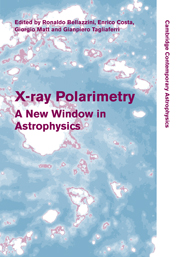Book contents
- Frontmatter
- Contents
- List of contributors
- Preface
- 1 X-ray polarimetry: historical remarks and other considerations
- Part I Polarimetry techniques
- Part II Polarized emission in X-ray sources
- Part III Future missions
- 37 Gravity and Extreme Magnetism SMEX (GEMS)
- 38 Programs of X-ray polarimetry in Italy
- 39 A polarimeter for IXO
- 40 Polarimetry with ASTRO-H soft gamma-ray detector
- 41 The Energetic X-ray Imaging Survey Telescope and its polarization sensitivity
- 42 PoGOLite: a balloon-borne soft gamma-ray polarimeter
- 43 Studies of neutron background rejection in the PoGOLite polarimeter
- 44 Observing polarized X-rays with PoGOLite
- 45 Pre-flight qualification tests of the PoGOLite detector system
- 46 The Gamma-RAy Polarimeter Experiment (GRAPE) balloon payload
- 47 POLAR: an instrument dedicated to GRB polarization measurement
- 48 Polarization detection capability of GRIPS
- 49 X-ray and γ-ray polarimetry small-satellite mission PolariS
- 50 GAP aboard the solar-powered sail mission
- 51 Hard X-ray polarimeter for small-satellite missions
- 52 Performance of hard X-ray polarimeter: PHENEX
- 53 GRB polarimetry with POET
- Author index
- Subject index
45 - Pre-flight qualification tests of the PoGOLite detector system
from Part III - Future missions
Published online by Cambridge University Press: 06 July 2010
- Frontmatter
- Contents
- List of contributors
- Preface
- 1 X-ray polarimetry: historical remarks and other considerations
- Part I Polarimetry techniques
- Part II Polarized emission in X-ray sources
- Part III Future missions
- 37 Gravity and Extreme Magnetism SMEX (GEMS)
- 38 Programs of X-ray polarimetry in Italy
- 39 A polarimeter for IXO
- 40 Polarimetry with ASTRO-H soft gamma-ray detector
- 41 The Energetic X-ray Imaging Survey Telescope and its polarization sensitivity
- 42 PoGOLite: a balloon-borne soft gamma-ray polarimeter
- 43 Studies of neutron background rejection in the PoGOLite polarimeter
- 44 Observing polarized X-rays with PoGOLite
- 45 Pre-flight qualification tests of the PoGOLite detector system
- 46 The Gamma-RAy Polarimeter Experiment (GRAPE) balloon payload
- 47 POLAR: an instrument dedicated to GRB polarization measurement
- 48 Polarization detection capability of GRIPS
- 49 X-ray and γ-ray polarimetry small-satellite mission PolariS
- 50 GAP aboard the solar-powered sail mission
- 51 Hard X-ray polarimeter for small-satellite missions
- 52 Performance of hard X-ray polarimeter: PHENEX
- 53 GRB polarimetry with POET
- Author index
- Subject index
Summary
Tests were performed on each section of each PoGOLite detector in order to characterize its behaviour, as well as to choose which detectors will be used in flight and in what configuration. We present the method and results of the tests of these detectors, as well as the strategy used for placing them in the instrument.
Introduction
The Polarized Gamma-ray Observer (PoGOLite) is a balloon-borne, Compton-based polarimeter, with an energy range of 25–80 keV. In the pathfinder instrument to be flown in August 2010, the detector system will employ 61 phoswich detector cells (PDC) and 30 side anticoincidence shield (SAS) detectors situated in an unbroken ring around the PDCs. The full size PoGOLite instrument will contain 217 PDCs. The previous tests and simulations of the detector system are explored in more detail in.
The 61 PDC and 30 SAS detectors must be arranged in a way which optimizes the detection efficiency of valid events, while also allowing for the virtually complete rejection of background. For this purpose, the light yield of each component of each PDC and SAS unit was measured, using radioactive sources with particles and energies to which the detector materials are most sensitive. The light yield of a detector indicates its efficiency and is given by the peak channel number in the spectrum.
- Type
- Chapter
- Information
- X-ray PolarimetryA New Window in Astrophysics, pp. 309 - 313Publisher: Cambridge University PressPrint publication year: 2010



